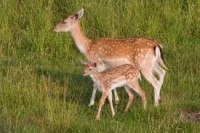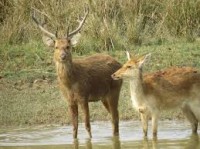 MONTGOMERY-The Alabama Division of Wildlife and Freshwater Fisheries (WFF) receives requests and proposals for various changes related to deer hunting each year from Alabama’s deer hunters. Suggestions for changes to bag limits for bucks and does, legal methods for taking deer, and ways to collect data from harvested deer are submitted through emails, phone calls and written letters. One of the most common requests received in recent years has been to allow deer hunting into part or all of the month of February, primarily due to neighboring portions of Mississippi and Florida being open for deer hunting during that time.
MONTGOMERY-The Alabama Division of Wildlife and Freshwater Fisheries (WFF) receives requests and proposals for various changes related to deer hunting each year from Alabama’s deer hunters. Suggestions for changes to bag limits for bucks and does, legal methods for taking deer, and ways to collect data from harvested deer are submitted through emails, phone calls and written letters. One of the most common requests received in recent years has been to allow deer hunting into part or all of the month of February, primarily due to neighboring portions of Mississippi and Florida being open for deer hunting during that time.
For the 2013-14 hunting season, hunters in Baldwin, Escambia, Mobile and Washington counties, as well as hunters in portions of Butler, Choctaw, Clarke, Conecuh, Monroe and Wilcox counties, will hunt deer hunt untilFebruary 10. These hunters will not have more total days to deer hunt than hunters in the other parts of Alabama since the deer season is closed from December 2-11 in that area. These 10 days of deer season were shifted to early February in response to the desires of many hunters in the area, as well as data collected over the years by WFF wildlife biologists.
 Hunters in several areas of Alabama have expressed displeasure with the traditional January 31 closing date of Alabama’s deer season for several years. Their complaints centered on their inability to hunt the rut in the area they hunted. Many felt most, if not all, deer breeding occurred after January 31 based on their inability to see and kill mature bucks during the season, lack of visible rut “sign” (i.e., scrapes, rubs, chasing behavior) during hunting season, and the increased deer activity they observed two to three weeks after the close of deer season. While much of their evidence for a late rut was anecdotal, some strong evidence existed that supported their concerns.
Hunters in several areas of Alabama have expressed displeasure with the traditional January 31 closing date of Alabama’s deer season for several years. Their complaints centered on their inability to hunt the rut in the area they hunted. Many felt most, if not all, deer breeding occurred after January 31 based on their inability to see and kill mature bucks during the season, lack of visible rut “sign” (i.e., scrapes, rubs, chasing behavior) during hunting season, and the increased deer activity they observed two to three weeks after the close of deer season. While much of their evidence for a late rut was anecdotal, some strong evidence existed that supported their concerns.
Since 1995, WFF staff members have collected data on the reproductive health of deer in many parts of Alabama. The  majority of sites sampled showed the majority of deer breeding occurred during the traditional hunting season framework (i.e., October 15-January 31), but some sites did show average conception dates at the very end of January and early February. Even after collecting 15 years of data, many areas of the state remained poorly sampled as late as 2009.
majority of sites sampled showed the majority of deer breeding occurred during the traditional hunting season framework (i.e., October 15-January 31), but some sites did show average conception dates at the very end of January and early February. Even after collecting 15 years of data, many areas of the state remained poorly sampled as late as 2009.
Increased data collection efforts by WFF staff beginning in spring 2010 did a very good job of filling in many of the conception date data gaps in Alabama. The increased data made it very clear most sites in some portions of the state had rut dates that went beyond January 31. The one area where the late dates were most consistent from site to site was southwestern Alabama. Data collected since 1995 show the average conception date in the new February hunting season zone is January 31, with 49 percent of the deer in the sample having conception dates after January 31. For comparison, deer collected in the remainder of the state had an average conception date ofJanuary 15, with 24 percent of the deer breeding after January 31.
 WFF’s Wildlife Section staff will continue to increase its reproductive health data collection efforts throughout the state in an effort to more clearly define areas with significantly early or late conception dates, but issues in certain regions dictated significantly increased sampling efforts beginning in 2013. One of these areas is the area adjacent to the current February season zone. The number of sites sampled in that area was greatly increased beginning in the spring and summer of 2013. As a starting point, a minimum of two sites in each county located south of U.S. Highway 80 were targeted for sampling. The increased effort will ultimately help determine the extent of the February season zone and may identify other areas that warrant further investigation.
WFF’s Wildlife Section staff will continue to increase its reproductive health data collection efforts throughout the state in an effort to more clearly define areas with significantly early or late conception dates, but issues in certain regions dictated significantly increased sampling efforts beginning in 2013. One of these areas is the area adjacent to the current February season zone. The number of sites sampled in that area was greatly increased beginning in the spring and summer of 2013. As a starting point, a minimum of two sites in each county located south of U.S. Highway 80 were targeted for sampling. The increased effort will ultimately help determine the extent of the February season zone and may identify other areas that warrant further investigation.
Another area of the state where biologists intensified their data collection efforts is along the Chattahoochee River valley region from Lee County to Houston County. Most of this area lies within the “south of Highway 80” zone where sampling was increased, but what makes this area unique is its distinctly earlier rut. Deer along the Chattahoochee River tend to breed in early to mid-December, rather than mid-January to early February. Shifting hunting days in this area from early in the season to February would not be justified based on conception date data, nor would it be well received by hunters in the region. The increased sampling will determine where the early breeding (early to mid-December) ends and the later breeding (mid-January to early February) begins.
valley region from Lee County to Houston County. Most of this area lies within the “south of Highway 80” zone where sampling was increased, but what makes this area unique is its distinctly earlier rut. Deer along the Chattahoochee River tend to breed in early to mid-December, rather than mid-January to early February. Shifting hunting days in this area from early in the season to February would not be justified based on conception date data, nor would it be well received by hunters in the region. The increased sampling will determine where the early breeding (early to mid-December) ends and the later breeding (mid-January to early February) begins.
As areas with distinctly different rutting periods are identified, additional management zones, such as the February season zone, may be recommended. Several criteria ultimately will determine whether these areas warrant a different season structure, including the size of the area (i.e., is it large enough to be considered a separate zone) and factors effecting conception dates (e.g., deer stocking source, management activities, etc.). These items, in addition to deer harvest data, public input and various other deer-related data, will ultimately determine the boundaries of any additional deer management zones.
MEDIA RELEASE/By Chris Cook, Wildlife Biologist, Alabama Division of Wildlife and Freshwater Fisheries



2 comments
Alabama’s late rut and December and January season definitely draws in more out of state hunters. Extending to February would bring in even more out of state hunters to take advantage of additional hunting opportunities.
Where in the world was the picture taken with all those big bucks in it?